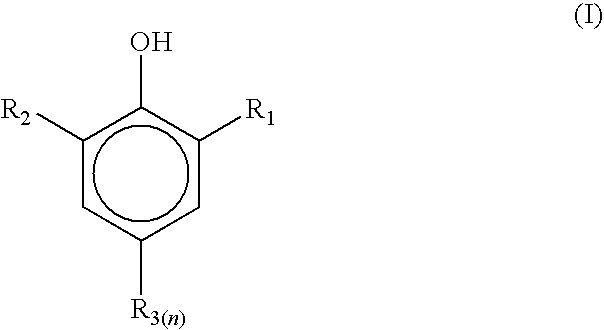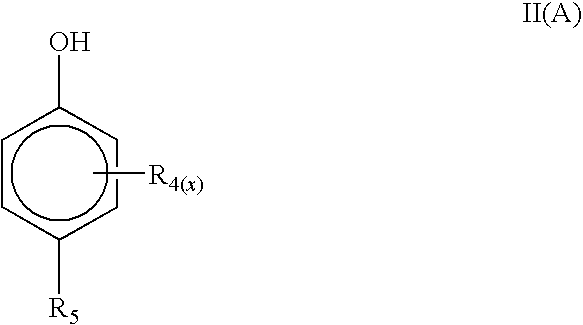Methods and compositions for improving stability of biodiesel and blended biodiesel fuel
a biodiesel and blend technology, applied in the petroleum industry, fuels, liquid carbonaceous fuels, etc., can solve the problems of destroying the intended use sludge and gum formation, and affecting and achieving the effect of improving the stability of the fuel source and the composition
- Summary
- Abstract
- Description
- Claims
- Application Information
AI Technical Summary
Benefits of technology
Problems solved by technology
Method used
Image
Examples
example 1
[0034]Tests were undertaken in accord with EN 14112, a.k.a. the Rancimat Test. The test is carried out by passing a steady stream of air through the heated (110° C.) sample and measuring the volatile oxidation species produced over a period of time. The point at which the rate of production of these volatile oxidation species reaches a maximum is defined as the induction period or oxidation stability, measured in hours at the given temperature.
[0035]Results are shown in Table I. The higher the hours resulting from the test, the longer the biodiesel “lasted” until it became rancid. Therefore, increasing the Rancimat test result number improves the biodiesel.
TABLE 1ExpectedHrs addedresult if noResultingActivesRancimatto stabilitysynergysynergydeliveredppmResultbybetween AOhrsNumberTreatmentprimaryAOActives MD(hr)treatmentand MDgainedC1None003.03nanaC2BHT50004.171.14na1BHT + MD500124.911.884.440.47C3DTBP50004.121.09na2DTBP + MD500124.781.754.390.39C4MD0123.300.27BHT = butylated hydroxy...
example 2
[0037]For these series of tests, the procedures set forth in ASTM D2274 were utilized. This test method measures the insolubles in fuels under specified oxidizing conditions at 95° C. In particular, the method calculates the total insoluble mass (mg / 100 mL) as the sum of the filterable insolubles and the adherent insolubles.
[0038]As used in the following table, the term “filterable insolubles” is the material produced in the course of stressing the fuel under conditions of this test that is then removable from the fuel by filtering after the test cell has been rinsed with hydrocarbon solvent. The “adherent insolubles” is the material that adheres to the glassware after the fuel has been stressed under the test conditions and flushed from the system with hydrocarbon solvent. “Total insolubles” is the sum of the adherent and filterable solids.
[0039]“Iso-octane insolubles” is run only on B100 and is the solids that precipitate from the filtrate plus iso-octane. These are the insolubles...
PUM
| Property | Measurement | Unit |
|---|---|---|
| weight ratio | aaaaa | aaaaa |
| temperature | aaaaa | aaaaa |
| stability | aaaaa | aaaaa |
Abstract
Description
Claims
Application Information
 Login to View More
Login to View More - R&D
- Intellectual Property
- Life Sciences
- Materials
- Tech Scout
- Unparalleled Data Quality
- Higher Quality Content
- 60% Fewer Hallucinations
Browse by: Latest US Patents, China's latest patents, Technical Efficacy Thesaurus, Application Domain, Technology Topic, Popular Technical Reports.
© 2025 PatSnap. All rights reserved.Legal|Privacy policy|Modern Slavery Act Transparency Statement|Sitemap|About US| Contact US: help@patsnap.com



